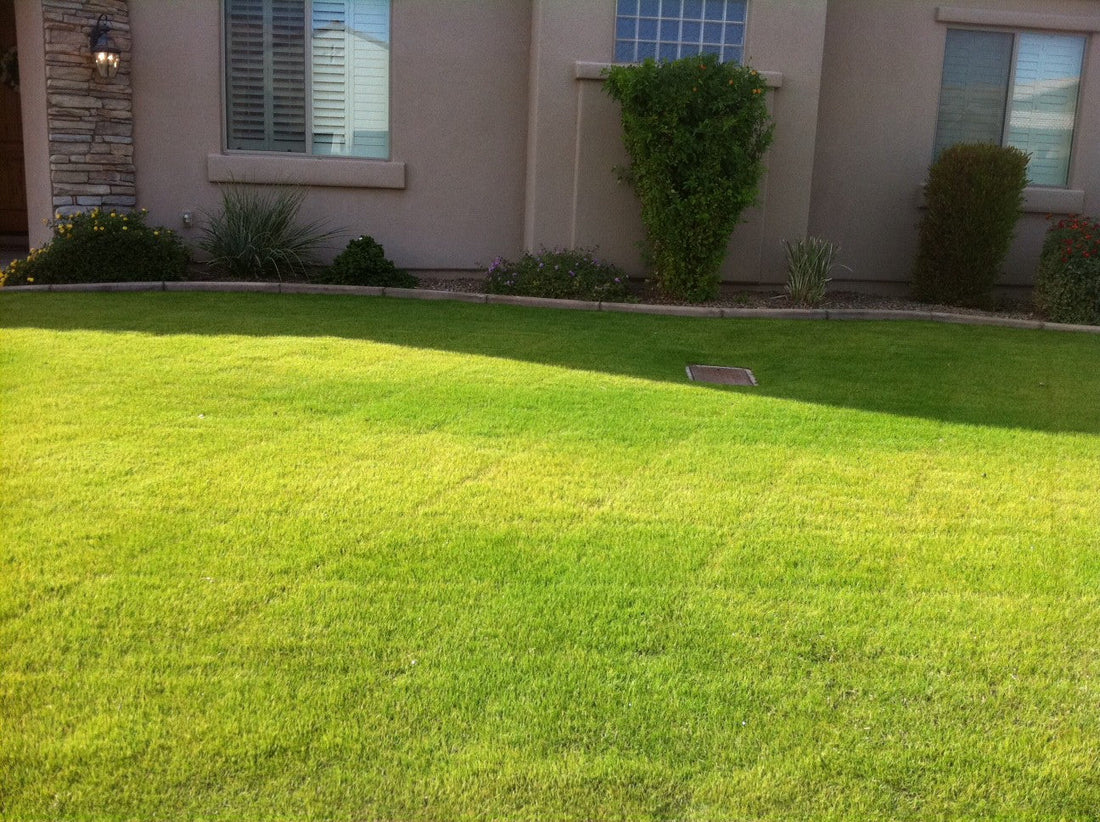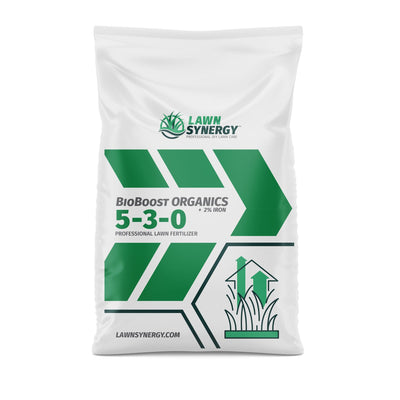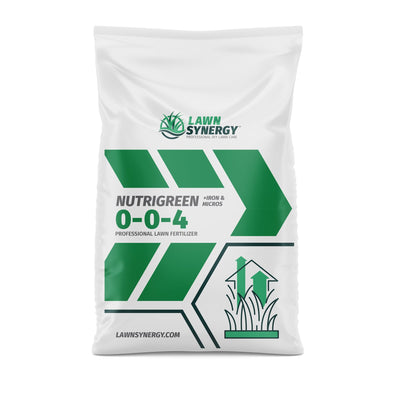Having a lush, green lawn is a source of pride for many homeowners. But achieving that vibrant color can be challenging. If you're looking for the best iron fertilizer for lawn, you've come to the right place.
In this article, we'll cover all things iron – what exactly iron is, the role it plays in fertilizer, what makes it the best lawn fertilizer, and how to apply it properly.
As lawn care experts, we pride ourselves on ensuring that your lawn receives the very best, which is why our premium lawn fertilizer collection is the best choice for you. So, if you're ready to learn about iron fertilizer, continue reading. Let's get started on transforming your lawn into the envy of the neighborhood.
What this article covers:
- What Is Iron?
- Why Is Iron Important For Your Lawn?
- Why Use Iron Lawn Fertilizer?
- How Do I Know If My Lawn Needs Iron?
- How to Apply Iron Lawn Fertilizer
What Is Iron?
Iron is a micronutrient essential for the formation of chlorophyll, which gives plants their green color. It's a key component in the process of photosynthesis, helping plants convert sunlight into energy. Without enough iron, your lawn can turn yellow and lack the vibrant green hue that makes it stand out.
We're proud to present our Emerald 10-0-20 with Iron Fertilizer, perfect if you're looking for the best fertilizer with iron. This product not only provides a balanced slow-release mix of essential nutrients but also includes iron to ensure your lawn stays healthy and green.
Some key features of our Emerald 10-0-20 Fertilizer Plus Iron include a high slow-release content to promote consistent growth, strength and disease resistance, and dark green color.
This combination makes it an excellent choice for maintaining health, beauty, and dark green color. .
Why Is Iron Important for Your Lawn?
Iron plays a vital role in maintaining a healthy lawn. It helps in the production of chlorophyll, which is essential for photosynthesis. This process not only gives your lawn its green color but also ensures it grows strong and resilient.
Iron is crucial for the formation of chloroplasts, the structures within plant cells where photosynthesis occurs. Without sufficient iron, your lawn can suffer from chlorosis, a condition that causes yellowing of the grass and reduces its ability to produce energy from sunlight.
By providing your lawn with the necessary iron, you help it to thrive and maintain its rich, green appearance.
Why Use Iron Lawn Fertilizer?
So, why should you use iron lawn fertilizer for your lawn? Let's delve into the reasons why:
Getting A Deep Green Color
From our experience, using iron fertilizers can significantly enhance the color of your grass. We found that iron helps produce a rich, deep green color that makes your lawn the envy of the neighborhood. Iron is essential for chlorophyll production, which is responsible for the green pigment in plants.
By adding iron to your lawn care routine, you can ensure a vibrant, healthy-looking lawn that stands out.
If you're looking for a reliable fertilizer with iron in it, our Organic Lawn Fertilizer 5-3-0 BioBoost is an excellent choice.
This product not only enhances the dark green color of your lawn but also provides a balanced mix of nutrients to support overall lawn health. Some key features of this fertilizer include its organic composition, which is safe for the environment and your family, and its slow-release formula that ensures long-lasting nourishment.
The addition of iron in this fertilizer makes it the best organic fertilizer for lawn, providing the essential nutrients needed for lush, green grass.

Improved Nutrient Uptake
Iron also aids in the uptake of other essential nutrients. According to our research, lawns treated with iron fertilizers tend to absorb nutrients like nitrogen and potassium more efficiently, leading to overall healthier grass.
Iron is crucial for chlorophyll synthesis, which enhances the plant's ability to capture sunlight and convert it into energy. This increased efficiency in photosynthesis boosts the plant's overall health and growth.
Moreover, iron improves the lawn's ability to uptake and utilize other nutrients present in the soil. For example, iron assists in the absorption of nitrogen, an essential element for vigorous growth and lush green color, and potassium. This strengthens the grass and enhances its resistance to diseases and environmental stress.
How Do I Know If My Lawn Needs Iron?
Look for signs of iron deficiency, such as yellowing between the veins of the grass blades, a condition known as chlorosis. Chlorosis typically starts at the newest leaves, turning them pale green or yellow while the veins remain darker.
This discoloration indicates that your grass is not producing enough chlorophyll, which is essential for photosynthesis and the overall health of your lawn.
Other signs include slower growth and an overall lackluster appearance.
If you notice these symptoms, it's time to consider adding iron to your lawn care routine. Conduct a soil test to determine the nutrient levels and confirm if iron supplementation is needed.
Iron supplements can quickly remedy deficiencies, restoring the vibrant green color and promoting healthier, more resilient grass. Regularly monitoring your lawn's condition and addressing any nutrient deficiencies promptly will help maintain its health and appearance throughout the year.

How to Apply Iron Lawn Fertilizer
The process of applying iron lawn fertilizer shouldn't be a hassle! Let's take a look at some practical tips:
Application
Choose the best iron fertilizer that suits your soil type and lawn needs. We recommend using chelated iron fertilizers for quick absorption. Chelated iron is more readily available to plants, allowing your lawn to quickly benefit from its application.
To apply, first conduct a soil test to determine the exact nutrient deficiencies and pH levels. This will help you select the most effective product for your lawn's specific conditions.
Once you've chosen the appropriate iron fertilizer, apply it evenly across your lawn using a spreader. Be sure to follow the manufacturer's instructions regarding application rates and timing.
Typically, iron fertilizers can be applied during the growing season, iron will need some nitrogen for the grass to pick it up but it doesn't need much. Water your lawn thoroughly after application to help the iron penetrate the soil and reach the root zone.
For liquid iron applications, mix the product according to the label directions and apply with a sprayer, ensuring even coverage. Liquid iron can be especially effective for a quick green-up, as it is rapidly absorbed by the grass blades.

Even Distribution
Ensure even distribution of the fertilizer to avoid patchy areas. Using a spreader can help achieve this. Uneven distribution of fertilizer can lead to inconsistent growth and color in your lawn, resulting in unattractive patchy areas.
We recommend using a broadcast or rotary spreader for larger lawns, as it covers a wide area and distributes the fertilizer evenly. For smaller lawns or precise applications, a drop spreader can be more effective, as it provides greater control over where the fertilizer is applied.
Additionally, it's essential to walk at a steady pace while using the spreader and to overlap slightly with each pass to ensure complete coverage. After application, water your lawn thoroughly to help the fertilizer penetrate the soil and reach the roots.
Watering
Water your lawn after applying the iron fertilizer to help the nutrients penetrate the soil and reach the roots. Proper watering ensures that the iron is effectively absorbed by the grass, promoting better nutrient uptake and healthier growth.
After applying the fertilizer, it's crucial to water your lawn thoroughly but not excessively. This helps dissolve the fertilizer and carry it down to the root zone where it's needed most.
This approach ensures that the fertilizer doesn't wash away and that the grass has a chance to absorb the nutrients effectively.
Be mindful of the weather conditions as well. Avoid watering during the heat of the day to prevent evaporation and water loss. Early morning or late evening watering is ideal, as it allows the water to soak into the soil without evaporating quickly.
Consistent, deep watering encourages strong root growth and ensures that your lawn remains lush and green.

Staining
Be cautious of staining on sidewalks and driveways. Iron can leave rust-colored stains, so be careful during application. When applying iron fertilizers, it's important to avoid overspreading onto concrete surfaces as these stains can be difficult to remove.
To prevent staining, use a spreader with a guard to direct the fertilizer only onto the grass. If any fertilizer does land on sidewalks or driveways, sweep it, or using a blower, blow off immediately to avoid staining.
Conclusion
Incorporating the best iron fertilizer for lawn into your lawn care routine can make a world of difference. It not only enhances the color of your grass but also improves its overall health.
At Lawn Synergy, we are committed to providing the best products and advice for your lawn care needs. Try our iron fertilizers today and see the transformation for yourself!
If you want to learn more, why not check out these articles below:
- Best Weed and Feed for Lawns
- Best Lawn Fertilizer for Texas
- Best Lawn Fertilizer for Florida
- Best Fertilizer for Clay Soil Lawn
- Best New Lawn Fertilizer
- Best Lawn Fertilizer for Sandy Soil
- Best Way to Grow Grass
- Best Weed and Feed for Bermuda Grass
- Best Fertilizer for Yellow Grass
- Best Fertilizer for Bahia Grass
- Best Fertilizer for Tall Fescue Grass
- Best Weed and Feed for St. Augustine Grass
- Best Fertilizer for Centipede Grass in South Carolina
- Best Grass Seed Fertilizer
- Best Fertilizer for Mondo Grass






